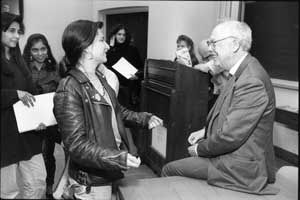‘Honest Jim: James D. Watson, the Writer’
Exhibition at Crerar highlights life of Chicago alumnus who co-discovered structure of DNA, wrote eight books
By Steve Koppes
News Office
 James Watson (right) chats with students following a talk he gave during a visit to the University back in 1993. Watson will return Monday, Jan. 19 for a lecture and reception for the opening of an exhibition at the John Crerar Library. The exhibition, “Honest Jim: James D. Watson, the Writer,” will be on display until Friday, May 28. |
Chicago alumnus James Dewey Watson (S.B.,’47), co-discoverer of the structure of DNA in 1953, will present a lecture on his recollections of his early life in Chicago and at the University at 4 p.m. Monday, Jan. 19, in the Biological Sciences Learning Center.
Watson’s lecture coincides with the opening of an exhibition, “Honest Jim: James D. Watson, the Writer,” which will run through Friday, May 28, at the John Crerar Library.
Watson shared the Nobel Prize in Physiology or Medicine with Francis Crick and Maurice Wilkins in 1962 for describing the structure of deoxyribonucleic acid, or DNA. Then a Harvard University faculty member, Watson became director of Cold Spring Harbor Laboratory on Long Island, N.Y., in 1968, its president in 1994, and its chancellor in November 2003.
From 1989 to 1993, Watson also served as director of the National Center for Human Genome Research at the National Institutes of Health. During that time, Watson launched the worldwide effort to map and sequence the human genome.
Meanwhile, he also became the author of eight books and numerous essays published in popular magazines. A colleague tagged him with the nickname “honest Jim” for his candid and controversial writing style. “What Watson writes about is the rivalry, the antagonisms, the human emotions involved in scientific inquiry,” wrote the Saturday Review in 1969 of The Double Helix. “His colleagues, the ebullient Crick and the cautious Wilkins, disclaimed the book.”
But, as Watson noted in an interview published in the July 2003 issue of Discover magazine, he had set out to write a good book, not a scientific treatise. In fact, he told Discover that he was more proud of his two books, The Molecular Biology of the Gene and The Double Helix, than he was of his co-discovery of the structure of DNA, simply because someone else would have soon discovered it if he had not.
Cold Spring Harbor Laboratory and the University Library are sponsoring the library exhibition, which comes to Chicago following a three-month run at the New York Public Library’s Science, Industry and Business Library.
The exhibition is packed with letters, books, photographs and other memorabilia. The books range from Watson’s own works to those of his favorite authors, including Sinclair Lewis’s Arrowsmith and F. Scott Fitzgerald’s The Great Gatsby.
The University augmented the New York displays with material that emphasizes Watson’s Chicago days. “We’re trying to personalize Watson but also highlight the University during that period,” said Barbara Kern, Science Reference Librarian, who organized the Chicago portion of the exhibition.
Among the items on display will be the University Senate minutes from Jan. 22, 1942, and the July 16, 1945 issue of Life Magazine.
The minutes record the vote that opened the way for the “Hutchins’ College.”
Named for President Robert Maynard Hutchins, the program allowed students to enter the University after two years of high school. Watson enrolled in the program in its second year, doing so as a 15-year-old graduate of South Shore High School in 1943. He graduated from Chicago in 1947 with an S.B. in Zoology. The Life Magazine profile of the University helped make Hutchins’ early admission program nationally known, Kern said.
Also in the exhibition will be Watson’s official transcript (displayed with his permission), a Chicago Maroon article covering the University’s last Big Ten basketball game that Watson attended, and other items related to professors whom Watson admired.
One of those items is a sketch of the late Joseph Schwab, the William Rainey Harper Professor of Natural Science, produced by an anonymous student. The sketch was found in an examination book from Schwab’s Observation, Interpretation and Integration course, which Watson took between 1945 and 1946.
The exhibition also reflects Watson’s lifelong interest in bird watching, which he has described in the manuscript of a forthcoming book. “He writes about trekking early in the morning in Jackson Park or down into the Lake County region to watch birds and gather species for his life list,” said University Science Librarian Kathleen Zar.
Watson’s Monday, Jan. 19 lecture will be followed by a reception for the opening of the exhibition at 5:30 p.m. in the John Crerar Library. The exhibition, which is on display in the library’s atrium, can be viewed during the library’s public hours, 8:30 a.m. to 5 p.m. Monday through Saturday.
![[Chronicle]](/images/sidebar_header_oct06.gif)